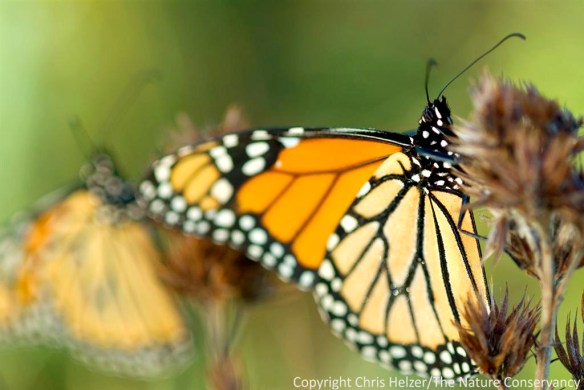Insect migration is a world we’re just starting to discover, and the more we find, the more fascinating that world is. One of the most recent discoveries involves Painted Lady butterflies (Vanessa cardui), a species found on every continent except Australia and Antarctica. Scientists in the United Kingdom knew that millions of painted ladies migrated north from North Africa each year. Until recently, they assumed it was a one-way trip. Now, innovative radar techniques show that the species migrates back to North Africa, taking advantage of high-altitude winds (up to 500 meters off the ground).
In case you’re wondering why painted lady butterflies would bother making the trip, the results from radar readings showed that in one year about 11 million butterflies came from Africa to the United Kingdom, and 26 million went back – so the species apparently benefits from migrating. (The butterflies that return are the offspring of the ones that come). You can a further description of the study here from Science Magazine’s website, and link from there to the full scientific article.
Back in May, I posted about what is being learned about how moths and butterflies migrate in North America. The story is similar, except that (at least at this point!) we think the majority of species migrate northward in the spring, but don’t return south. Sounds like a great project for someone to look into!
I’m particularly fascinated by multi-generational migrations. In North America, we’re familiar with the monarch butterfly migration, which takes place over four generations – each successive generation traveling the next leg of the journey. The fact that each new generation of butterflies knows where to go and how to get there, without having been taught, is about as fantastic a natural phenomena as I can think of.
Monarchs are not the only four generation insect migrant. In fact, there’s a fantastic story about the globe skimmer dragonfly that migrates back and forth from India to Africa over four generations as well – using high-altitude wind currents like the painted lady butterfly. You can read more about that dragonfly migration here.
Continuing advances in technology are allowing us to learn more and more about the lives of insects and other small creatures. We’re starting by looking at the migrations of large showy insects such as butterflies, moths, and dragonflies, but I wonder how many smaller, less charismatic species are making long-distance trips that we’ve just never noticed. I’m looking forward to reading many more fascinating stories as the data keeps coming in.
Don’t you just love science?



Thanks Chris for posting the butterfly stories.
Our God is awesome!
Had a very pleasant surprise to see that the article you linked to in Science Magazine was written by a good friend from VA. A very small world of science. Love the articles. Trying to figure out what advantage there is for multi-generational migration. If you can survive the winter why head south every so often?
Multigenerational migrants, the monarch butterfly being a good example, cannot survive the winter throughout most of their breeding range.
Thank you! So the multigenerations occur in the passage of one summer?
I love your enthusiasm about insects migrating. They say it’s good to learn something new each day, and I am glad it was your information. ;o) I never thought about other butterflies or even other insects migrating. I love that painted lady photo, and was tickled that I recognized the ironweed before looking at your caption.
The migratory capacity of the painted lady has been known for a long time. The article could have mentioned this publication of the Lepidopterist Society, 1970, where there are some observations of southern flights in the fall. http://peabody.research.yale.edu//jls/pdfs/1970s/1970/1970-24(3)157-Williams.pdf
There are many others that you can google.
Beatriz – what a fascinating article; thanks very much for sharing it! It appears the recent information about flights between the UK and North Africa add some details to what has been a recognized phenomenon (as you say) for a long time. Great to know. The movement patterns in North America were also very interesting to read about.
Pingback: Photo of the Week – September 26, 2013 | The Prairie Ecologist
My thought on butterfly migration is that every generation must be genetically programmed to do every leg of the migration, but that conditions trigger the appropriate behavior at the right times, and the part of the migration a given generation is destined to accomplish is based upon the conditions it was born into. No generation will live long enough to do everything its genes are programmed to do, but teach successive generation of nearly identical butterflies will continue on with the next phase of life. I’m no naturalist but this seems logical. Do you know if it’s right? Or are there developmental differences in successive generations based on conditions?
I don’t really know how the monarchs are wired either. It seems crazy that the migration system across generations works at all! How do they know they’re supposed to go to Mexico, and where specifically to go? But really, we have the same questions about lots of other migrants, including many insects.
Pingback: The Painted Lady Butterfly: This Year’s Poster Child for Insect Migration | The Prairie Ecologist